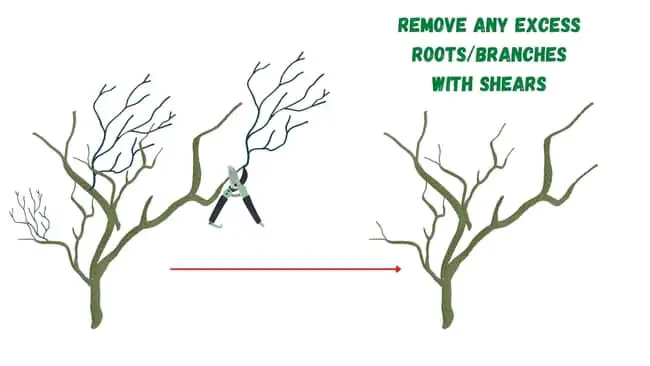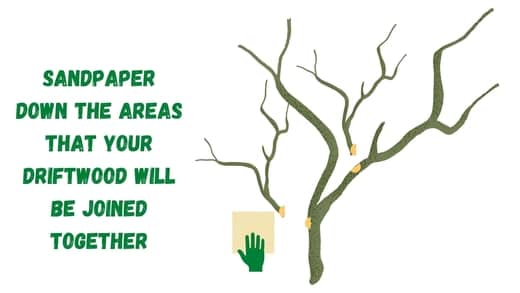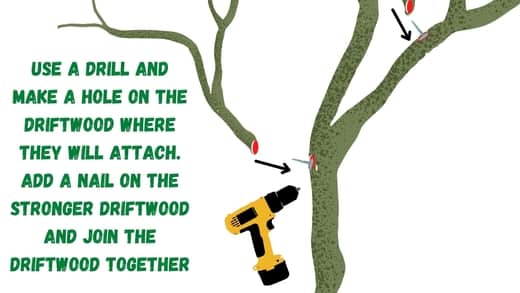This website is supported by its readers. If you click one of my links I may earn a commission. I am also a participant in the Amazon affiliates program and I will also earn a commission from qualified purchases.

One of the things that I recently came across that has added to my aquarium is using my knowledge of bonsai trees and creating bonsai driftwood for an aquarium. So how do you make bonsai driftwood for an aquarium?
To make bonsai driftwood, locate wood of varying sizes from rivers, lakes, and streams. Then using adhesive and screws attach these wood pieces to resemble a bonsai. Add moss such as Monte Carlo to the branches to create a leaf-like structure.
So what exactly is bonsai driftwood? And what plant/tree pieces work best to create bonsai driftwood for aquariums? Keep reading to find out more!
Just a quick heads up, over the past three years of running Plantpaladin, hundreds of people have asked for product recommendations. As such, You can find my favorite indoor bonsai tree here (link takes you to Bonsaiboy), my favorite outdoor bonsai tree (link takes you to Bonsaiboy), or have a look at all the products I recommend here.
How to make bonsai driftwood for an aquarium?
Adding bonsai driftwood to an aquarium can help drastically change the look of your aquarium to a tropical zen-like paradise.
Although bonsai driftwood used in aquariums is not a real bonsai tree that you have dumped into your tank – it can make a more aesthetically pleasing habitat for both your fish and you.
Whilst purchasing bonsai driftwood from stores is the easiest option to adding bonsai driftwood to an aquarium, it can add up in price.
Being the bonsai enthusiast that I was, I wanted to figure out how to make bonsai driftwood for an aquarium.
As such, I got in touch with my local aquatics retailers, visited a few friends of mine who are fish enthusiasts, and even asked 10 plant paladin readers who also keep fish as a hobby.
To make bonsai driftwood for an aquarium then:
- Gather your materials
- Come up with a design
- Remove any excess branches or roots
- Sand your wood down
- Join your wood pieces together
- Create the leaves
- Soak your driftwood
- Anchor the tree to the bottom of the aquarium
Let’s explore these in more detail:
Gather your materials
Easily the most important step in creating bonsai driftwood for an aquarium from scratch is selecting the right material.
Part of the reason why buying store-bought bonsai driftwood for aquariums is so expensive is the amount of time it takes to find the right materials.
Luckily, with a bit of patience, you too can find the perfect bonsai driftwood for your aquarium.
Where should you get driftwood from
Driftwood can be gathered from many different places but a few of my favorites include:
- Lakes, streams, rivers, or any space with flowing water
- Stump dumps
- Lawn waste spaces
- Recycling plants
- Woods
- Forests
- Landscaping companies
If you decide on getting driftwood from lakes, streams rivers, or from the wild, just ensure that the wood you get is near flowing water.
Driftwood near flowing water will mean that there is less of a chance of harmful algae building up on the driftwood.
This can potentially kill the fish in your aquarium so you need to take care if getting the wood from outdoors.
I found that gathering wood from green recycling plants does not have this problem.
What size driftwood should you get?
The size of the bonus driftwood you decide to opt for should be in line with your aquarium.
If you have a large fish tank then the pieces of wood you gather can be larger to create bigger bonsai driftwood.
If however, you have a small tank, then carrying around large logs of driftwood will obstruct the fish tank making your fish feel claustrophobic.
The best thing to do in my opinion is to grab multiple different sizes of driftwood.

Having multiple sizes of wood that you will join together to mimic the look of a bonsai will make the process easier and ensure you have the perfect size bonsai driftwood for your aquarium.
What plant/tree driftwood works best
Whilst pretty much any driftwood you find can be effectively joined together there are some caveats you need to be aware of.
Getting driftwood from branches or the trunk of your tree might be weaker than other parts such as the roots.
After a few years, the water will cause these parts of the plant to weaken, causing your bonsai driftwood to fall apart.
In my opinion, the best type of driftwood you can use is the root structure/root stump of an older plant.
Root structures are usually a lot tougher than the branches of their respective trees and can last for decades under high water conditions.
They also sink a lot faster making them ideal for aquariums
Root structures and root stumps from Azaleas and Rhododendron work well as they already have multiple roots which mimic the look of the branches of a bonsai tree.
Just ensure that you will need to rip these out of the ground and let them dry out for at least 9 months before you can use them for bonsai driftwood
What materials work best for the leaves?
Now you’ve gathered the materials for the “branches” of your bonsai driftwood, we need to come up with material that will be used for the leaves.
Luckily there are a few fantastic options you can use.
Fish safe algae, mosses, and aquatic plants can all be used when creating bonsai driftwood but a few of my favorites include:
- Marimo Moss
- Xmas Moss
- Java Moss
- Monte Carlo
Come up with a design
Whilst it can be tempting to improvise and design your bonsai driftwood from scratch, in my experience (i.e failing about 5 times before I decided to do this correctly) designing exactly how you want your bonsai driftwood to look will massively help you create bonsai driftwood.
Doing something as simple as drawing out on a piece of paper, or mimicking a bonsai tree species such as juniper, jade, scots pine, or styles such as sumo or informal upright, will help give you something to aim for.
It’s important to do this after you have gathered your materials as you will know the different sizes and looks of the wood that you are working with.
For example, if you have found a root stump structure with many different roots you can design bonsai driftwood with many “branches”.
If however, you have only found 2 or 3 pieces of wood that are relatively straight and narrow, this will change the look of your tree.
Doing that will give you something to aim for and make the process easier.
You can always change this as you go along, but in my experience, this step is not worth skipping.
Remove any small branches or roots
Before we start joining our wood together you likely need to clean up the branches you are working with to make them easier to work with.
This will be especially apparent in root stump structures that have a lot of rootlets.
Luckily, this process is fairly straightforward.

Using shears, trim back any secondary or tertiary branches/roots until you have only the strongest thickest roots or branches on your tree.
This will ensure that the silhouette of your bonsai driftwood aquarium remains visually pleasing to look at and not a mess.
Repeat this process for all the driftwood you have gathered.
Sand your wood down
Whilst you can start joining your wood together at this stage, for best results I found that sanding down the places where your driftwood will join each other works best.
This will increase the chance of making the wood hold together for longer when you join them together.
Failing to sand the joining areas of your wood down will mean that the bark will eventually flake off.
Simply grab a piece of low grit sandpaper and sand down the joining areas of your existing wood.

Join your driftwood together
Now it’s time for the fun part.
So you’re existing driftwood has been prepared but sadly it looks nothing like the design you came up with.
The next step then of creating bonsai driftwood for your aquarium is to join your driftwood together to make it look like a tree.
There are two main methods of doing this:
- Using nails and a drill
- Using glue or epoxy
Both these methods can be used together.
Using nails and a drill
To use nails and a drill to join your driftwood together, drill a small hole in the two-piece of driftwood you would like to join together.
Then in one of the holes (ideally the hole in the stronger larger piece of driftwood) place one nail in the hole.
This nail will anchor and hold the other driftwood piece together.
Then simply screw or place the other driftwood on top of the nail and the two-piece of driftwood should hold together.

Using glue or epoxy
Glue and or epoxy also works very well when connecting or joining two pieces of driftwood together.
To do this, apply a large amount of paste to the two spots of driftwood you are joining together and create a ring of epoxy around the two joints so they are joined together.
Leave this in place to dry for about 24 hours and the solid hardened glue will have created a solid joint between the two pieces of driftwood.

What epoxy works best for bonsai driftwood?
Without a doubt, the best epoxy/glue I have used for creating bonsai driftwood would be the Kwickwood repair epoxy putty which you can grab here (link takes you to Amazon)
Not only does this epoxy match the color of the wood you are working with, but it also comes as a putty meaning you can mold the putty around the driftwood you are joining together the get the best finish possible.
This is also non-toxic to fish and is also waterproof making it ideal for underwater aquarium landscaping.
Can you use glue and the nail technique?
If this is the first time you are creating bonsai driftwood, then I would recommend using both the nail and epoxy method together to create a super-strong fusion between your two driftwood pieces.
Start by using the nail and screw technique and then finish off by using the epoxy on the outside to create a stronghold.
Then repeat the process amongst the rest of your tree until it resembles the look of a bonsai tree without leaves.
Create the leaves
So now you have driftwood that looks like a bonsai tree but is missing the leaves and canopy of the tree.
To add leaves to the tree of your bonsai then select the material that will work for your tree.
As discussed earlier I found the following work best:
- Marimo Moss
- Xmas Moss
- Java Moss
- Monte Carlo
If you are a complete beginner I would consider using the Marimo moss balls as they are super easy to use and can grow pretty much in any condition.
If you are using mosses, unfurl them and place them on the top “branches” of your bonsai driftwood.
The branches should hold them in place but in case you have trouble keeping these attached, use pins, needles, or super glue to hold them in place.
Now if you are feeling ambitious you can use something like the Monte Carlo.
Just be sure to pinch off the roots and place them on top of the branches of the driftwood.
Over time, the new roots will grow on the driftwood and the Mote Carlo will increase in size.

Soak your driftwood
So your driftwood tree is complete and almost ready to be placed into your aquarium.
There are just a few things you need to do to prepare it before we move it into its new home.
The next step then is to soak your bonsai driftwood in a bucket or a bath.
The driftwood you will have created will be very buoyant, even with the moss and the added weight of your bonsai structure.
Soaking the wood will make it more likely to sink to the bottom of your aquarium.
Now if you have used branches and twigs in your driftwood designs as opposed to root structure, and are worried about your bonsai driftwood falling apart — before you start the driftwood process, boil your wood.
This will help sterilize the wood and help release tannins.
Place your driftwood in the aquarium
It’s time for the big moment!
All the hard work has been done and now it’s time to simply place your bonsai driftwood in your aquarium.
Whilst you have soaked your bonsai in water, in the first few weeks, you still might need to anchor the driftwood to the bottom of the aquarium.
To do this, use rocks to hold the base of your driftwood in place.
Alternatively, use the pebbles or stones on the base of your aquarium to hold the driftwood in place.
FAQ’s around bonsai driftwood
Now I’m sure some of you will have questions about How to make bonsai driftwood for aquariums as such, I’ve listed a few frequently asked questions below:
What is bonsai driftwood for aquariums?
Bonsai driftwood for aquariums is deadwood pieces of wood that are joined together to mimic the look of an underwater bonsai tree. Bonsai driftwood is not a traditional bonsai tree that is placed underwater.
What bonsai species work best for bonsai driftwood
The root, trump, and trunk structures of azaleas and rhododendron plans species work best for bonsai driftwood. These root structures are very strong and water-resistant making them perfect for aquarium use for many years.
Advantages of bonsai driftwood
The main advantages of bonsai driftwood are:
- Makes for a more visually pleasing aquarium
- Can add value should you decide to sell your tank
- Can make for a happier environment for your fish
Disadvantages of bonsai driftwood
The main disadvantages of bonsai driftwood are:
- They can cost a lot of money should you get them from a store
- Bonsai driftwood can take a large amount of time to create from scratch
- After a few years, bonsai driftwood will begin to fall apart.
Is bonsai driftwood toxic to fish?
Not all bonsai driftwood is safe for use in aquariums or fish. As such, driftwood if bought from the store should be marked as safe for fish use. Driftwood from the wild should be dried out for a year before use in fish tanks.
Wild driftwood should not be picked from still lakes as this can build up to harmful algae.
Can you put a bonsai tree in an aquarium?
Traditional bonsai trees should not be placed in an aquarium. This is because most bonsai are susceptible to overwatering and left in an aquarium will kill the plant. Instead, bonsai driftwood should be used.
Where can you buy store-bought bonsai driftwood?
Bonsai driftwood can be purchased from any reputable aquatic retailer. Bonsai driftwood can also be purchased online from amazon.
My favorite store-bought bonsai driftwood can be found here – the link takes you to Amazon.
It’s especially good as it comes in a wide variety of sizes and has tons of branches that are great for adding moss.
How much does bonsai driftwood cost?
Bonsai driftwood, if purchased from a retailer, can cost between $30 to $80 with more premium bonsai driftwood costing hundreds of dollars. Making bonsai driftwood from scratch can be significantly cheaper with the cost of materials usually being $10.
My top picks for the gear you will need!
So like I mentioned earlier, over the past three years of running PlantPaladin, hundreds of people have asked me for my recommendations on the best bonsai gear on the market.
Having spent thousands of dollars on bonsai items these past few years and tested at least 100 bonsai-specific products, I’ve listed my favorite products below – All of which I highly recommend and think you can get great value.
They can purchase directly by clicking the link to take them to Amazon.
Bonsai Tool Set: One of the significant challenges I’ve had is finding a toolset that was not only durable but didn’t break the bank. SOLIGT has recently developed a fantastic bonsai tool set that covers all the tools you need to trim, prune, and repot your trees. – You can grab it here.
Complete Bonsai Set: Many of you will want to grow your bonsai trees entirely from scratch, but finding the varicose seeds, pots, and other items in one place can be challenging. Leaves and Sole then have created a complete bonsai set that I’ve personally used that ticks all the boxes. You can grab it here.
Bonsai wire: The number of times I’ve run out of wire for my bonsai or purchased cheap bonsai wire that doesn’t do the job is embarrassing for me to admit. After a lot of trial and error, I found that using Hotop’s aluminum bonsai wire is one of the best options on the market. This can easily be used for both indoor and outdoor bonsai. You can grab it here.
This post was written by Fehed Nicass who has been passionate about bonsai for over 3 years.
